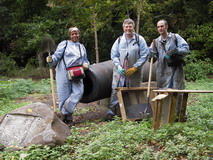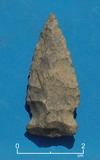| History in the Soil: Archeology on Davids Island |
|
Archeology provides an avenue for understanding and appreciating the history of Fort Slocum and Davids Island that complements the study of historical documents, buildings and structures, and oral histories.
The archeological record at Davids Island begins long before the first soldier stepped ashore in the early months of the Civil War. Archeological investigations show that the human history of the island stretches back at least 4,000 years, to a time when northeastern North America was occupied solely by Native American hunter-gatherers. From this time onward, visitors and residents occasionally lost, forgot, abandoned or discarded durable objects that were mixed in the soil and today are tangible reminders of the island’s history.
The sound of the bulldozer is loud in the land…. The carpet of the past is being rolled up behind us as we advance into the future, and before long when we look over our shoulders we shall see nothing but the mirror of ourselves.” —Ivor Noël Hume, "Historical Archaeology" (1969) (Copyright © 1969 by Ivor Noël Hume Originally published by Alfred A. Knopf. Reprinted by permission of Curtis Brown, Ltd.) |







